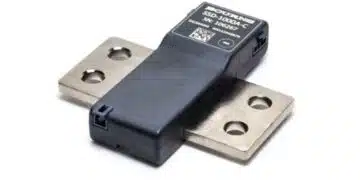source: Nichicon article
In the automotive and onboard automotive-related areas, the performance of equipment such as advanced driver assistance systems (ADASs) is progressing together with the advancement of space-saving mounting parts to ensure comfortable vehicle interiors. To this end, even individual capacitors must conform to harsh environments, miniaturization and high-capacity requirements.
The latest technological trends in automotive onboard aluminum electrolytic capacitors are as follows.
UCV/UCH series of chip-type aluminum electrolytic capacitors with expanded ratings While NICHICON’s compact, high-capacity UCM series lineup meets demands for small sizes, the UCV series (image 1), realizes an even smaller size with an expanded rating to 16V. This product utilizes high-magnification anode foil, thinner cathode foil and thinner electrolytic paper to realize a smaller size than existing products. The product dimensions are Φ6.3 x 7.7L to Φ10 x 10L, the rated voltage range is 16–35V and the rated capacitance range is 220–1,500μF.
In addition to NICHICON’s UCZ series product line, we developed the UCH series realizing a more compact size and lower ESR. This product utilizes the electrolytes with low evaporation and low resistance and an optimized internal structure that, compared to the Φ6.3×7.7L dimensions of existing products, features a 75% reduction in the rate of increase of low temperature ESR to initial values after endurance testing. In October 2017, this product was expanded to a rating of 25V, product dimensions of Φ6.3×7.7L to Φ10×10L, a rated voltage range of 25–35V and a rated capacitance range of 47–560μF.
Along with high-density packaging, demands for products that are compact, high-capacity and high-performance are increasing, thus we plan to further heighten specifications in the future.
![]()
GYA series of conductive polymer hybrid aluminum electrolytic capacitors
Vehicle onboard electronic control units (ECU) and other components are frequently installed in the engine compartment, a high temperature environment. Aluminum electrolytic capacitors with a longer life and higher ripple current tolerance are now in greater demand than ever. To meet these needs, NICHICON developed the GYA series of conductive polymer hybrid aluminum electrolytic capacitors.
The GYA series utilizes hybrid electrolytes obtained by fusing conductive polymer and electrolytic solution and applying proprietary conductive polymer formation technologies to realize low ESR performance. In addition, by newly developing an electrolytic solution adapted to conductive polymer, low leakage current performance, which is a feature of the electrolytic solution, is achieved without impairing the performance of the conductive polymer. Furthermore, the adoption of conductive polymer that does not dry up makes it possible to extend the life even under high temperatures.
This lineup has product dimensions of Φ6.3×5.8L to Φ10×10L, a rated voltage range of 25–63V and a rated capacitance range of 10–330μF. The endurance rating is guaranteed for 4,000 hours at 125°C.
In the future, conductive polymer hybrid aluminum electrolytic capacitor applications are expected to expand and the market is expected to grow. In the automobile market, steady progress has been made and automated driving, ADAS and other technologies continue to expand as automotive electronics and high functionality advance even further. In light of this, NICHICON will promote the development of even higher capacity, heat resistant and high withstand voltage products.
In addition, we intend to expand lineups, from low- to medium voltage in response to consumer markets including home appliances, communication equipment and industrial equipment.
UXY series of lead-type aluminum electrolytic capacitors
ECUs usage has increased due to automotive electronics and the rise of electric and hybrid vehicles (EV/HV). The number of electronic components has also increased. ECUs are located in various places in an automobile and are connected by a wire harness with a tendency for the ECU to be concentrated in the engine compartment to simplify communication wiring and integrate electric machinery for a high degree of control. There is also a tendency to move the ECUs to the engine compartment to expand space in response to user needs for vehicle interior comfort and ensuring space for the trunk compartment. ECU’s mounted in the engine compartment must withstand high temperatures and high vibrations, the capacitors must also withstand these same conditions. The UXY series was developed to meet the demands for high temperature and vibration resistance.
![]()
The UXY series of vibration-resistant lead-type aluminum electrolytic capacitors
The vibration resistance of aluminum electrolytic capacitors must take into consideration the external terminals and internal lead structure fracturing. Regarding external terminal fractures, countermeasures can be taken to fix the aluminum electrolytic capacitor itself using a casing or potting material. However, with respect to the fracturing of internal leads, countermeasures are necessary within the aluminum electrolytic capacitor itself. Regarding the cause of internal lead fractures, in manufacturing aluminum electrolytic capacitors, the element diameter is designed to be smaller than the cases’ inner diameter to insert and seal the element in the case resulting in a gap between the element and the case inner wall. For this reason, under vibration, lead fatigue occurs due to vibration of the element within the gap inside the case, resulting in the lead wire fracturing. By eliminating this gap, fractures can be avoided, thus we developed a proprietary slitted (grooved) case. Figure 1 compares the structure of the UXY series to existing products.
【Figure 1】 Comparison of construction of previous product and UXY Series
![]()
Since the inside of the slitted case has a convex shape extending from near the case center to the bottom of the case, the gap between the element and the inner wall of the case is greatly reduced compared to existing products. This significantly suppresses internal element vibration compared to current products, realizing high vibration resistance. Our new slitted (grooved) case has 6 convex shaped indentations that extend from the center of the can to the bottom. These grooves hold the element firmly in place which significantly increases the vibration resistance of the capacitors.
Our research has determined 6 slits (grooves) to be the optimal number of grooves required to give maximum vibration resistance without having to change our production processes and without reducing the internal volume.
【Figure 2】 Results of number of slit simulations (Φ18×40L-equivalent element subjected to acceleration of 392m/s2 )
![]() 【Table 1】 Vibration test results
【Table 1】 Vibration test results
![]()
*The test was carried out in the order of X direction, Y direction, Z direction with the same product.
UXY series specifications are shown below. Product dimensions are Φ18×31.5L and Φ18×40L, with a category temperature range of -40 to 135°C, a life of 3,000 hours, a rated voltage range of 25 to 50V and a rated capacitance range of 2,300 to 11,000μF. The vibration resistance performance is 10 to 2,000Hz in frequency, the amplitude and rate of acceleration is 1.5 mm or 392 m/s2 (40G), whichever is looser, the sweep speed is 0.5 octaves/minute and the vibration direction and time are X, Y and Z, two hours in each direction for a total of six hours (fixed product with fixture).
We developed the UXY series in order to meet actual user requirements and we were also able to improve the performance of our products because of these strict demands. While the maximum acceleration may be severe due to vibration resistance performance requirements, there are also cases where acceleration may be relatively gentle over a long period of time. Although user vibration resistance requirements may vary, vibration resistance performance for automobile electrical equipment will always be necessary. For this reason, although the UXY series is rated for up to 40G of vibration acceleration, we will respond to various vibration resistance requirements individually and meet the demands of automotive electrical systems.
Going forward, we will develop new technological innovations to meet even higher specification demands (high temperature resistance, compact size, high ripple tolerance, low ESR) in anticipation of higher aluminum electrolytic capacitor vibration resistance requirements in powertrain ECUs.































